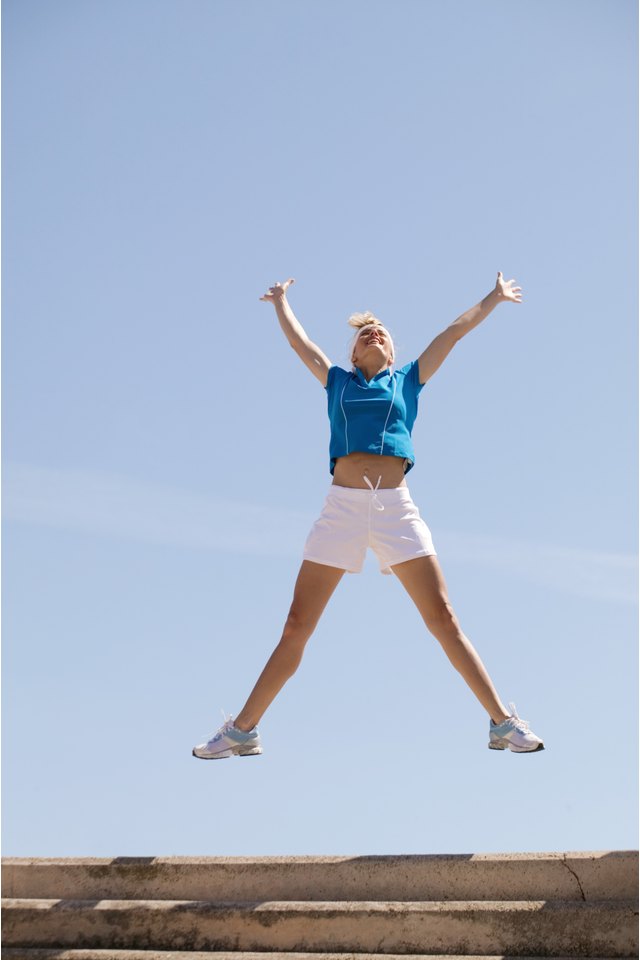What does fact checked mean?
At SportsRec, we strive to deliver objective content that is accurate and up-to-date. Our team periodically reviews articles in order to ensure content quality. The sources cited below consist of evidence from peer-reviewed journals, prominent medical organizations, academic associations, and government data.
The information contained on this site is for informational purposes only, and should not be used as a substitute for the advice of a professional health care provider. Please check with the appropriate physician regarding health questions and concerns. Although we strive to deliver accurate and up-to-date information, no guarantee to that effect is made.
Jumping Jacks and Ankle Injuries

Jumping jacks might not be your go-to aerobic workout, but the benefits of performing them are huge. This high-impact movement can burn major calories, but when done improperly can cause injuries to the lower body, particularly the ankles and knees. It’s essential to perform jumping jacks correctly and focus on the quality rather than the quantity of the exercise to reduce risk to your joints.
Benefits
Jumping jacks can be a great warm up to another aerobic exercise or you can increase the intensity and make them the main event in your workout. Performing jumping jacks will increase your heart rate and blood circulation, both excellent for your cardiovascular health. You can also build endurance and strengthen your muscles with jumping jacks. Just two minutes of jumping jacks three times a day can burn an additional 60 calories, according the Joy Bauer of Health on Today. It’s an easy and no-cost exercise to boost your metabolism even on your busiest day.
Muscles Worked
Jumping jacks require explosive movements that are high impact. The muscles that are activated the most during jumping jacks are the hips, glutes, thighs, calves, shoulders and chest. Your calves contract during the push-off phase of the jumping jack and also during the landing phase. The hips, glutes and thighs are contracted as you move your legs away from your center of gravity and also when you pull back toward your center of gravity. As you move your arms upward during a jumping jack you engage your shoulder muscles, and as you move them back down to your sides you engage your chest muscles.
Risks
Injuries can happen with any sport or aerobic activity, but you pose a greater risk of injury with high-impact exercises. Not only are injuries to the ankles common with jumping jacks, but there’s also the risk of injury to the knees, back, hips, shoulders and elbows, according to the University of Maryland Medical Center.
Preventing Injury
It’s possible to prevent injury during jumping jacks. Wearing shock-absorbing athletic shoes that also have weight-dampening inserts can be useful. Focusing more on form rather than speed can also prevent injuries with jumping jacks. Stand with your feet together and keep your knees bent slightly. Raise your arms and separate your legs to the sides and land on the forefoot during the initial jump phase of the exercise. Jump again lowering the arms and returning the legs to the center simultaneously. Always land with your knees slightly bent so that the muscles are receiving the impact rather than the joints of the knees and ankles. Also make sure to warm up and cool down properly before and after a workout.
Treating Injury
To treat a minor ankle injury such as a sprain you should follow the four-step treatment known as RICE. This requires rest, ice, compression and elevation. Rest the injury, apply ice packs to reduce inflammation for the first few hours following the injury, tape or brace the injury and elevate following the compression. Swelling should decrease within 48 hours, according to the University of Maryland Medical Center. Do not apply pressure to the injury until pain has completely subsided.
References
Writer Bio
Danielle Clark has been a writer since 2009, specializing in environmental and health and fitness topics. She has contributed to magazines and several online publications. Clark holds a Bachelor of Science in ecology and environmental science.
